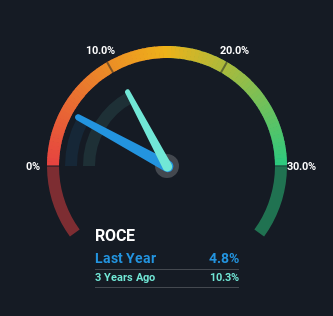If you're looking for a multi-bagger, there's a few things to keep an eye out for. Typically, we'll want to notice a trend of growing return on capital employed (ROCE) and alongside that, an expanding base of capital employed. Basically this means that a company has profitable initiatives that it can continue to reinvest in, which is a trait of a compounding machine. Although, when we looked at Deewin Tianxia (HKG:2418), it didn't seem to tick all of these boxes.
What Is Return On Capital Employed (ROCE)?
If you haven't worked with ROCE before, it measures the 'return' (pre-tax profit) a company generates from capital employed in its business. To calculate this metric for Deewin Tianxia, this is the formula:
Return on Capital Employed = Earnings Before Interest and Tax (EBIT) ÷ (Total Assets - Current Liabilities)
0.048 = CN¥217m ÷ (CN¥10b - CN¥5.6b) (Based on the trailing twelve months to June 2024).
Therefore, Deewin Tianxia has an ROCE of 4.8%. On its own, that's a low figure but it's around the 5.9% average generated by the Transportation industry.
See our latest analysis for Deewin Tianxia

Historical performance is a great place to start when researching a stock so above you can see the gauge for Deewin Tianxia's ROCE against it's prior returns. If you'd like to look at how Deewin Tianxia has performed in the past in other metrics, you can view this free graph of Deewin Tianxia's past earnings, revenue and cash flow.
The Trend Of ROCE
In terms of Deewin Tianxia's historical ROCE movements, the trend isn't fantastic. Over the last four years, returns on capital have decreased to 4.8% from 10% four years ago. On the other hand, the company has been employing more capital without a corresponding improvement in sales in the last year, which could suggest these investments are longer term plays. It's worth keeping an eye on the company's earnings from here on to see if these investments do end up contributing to the bottom line.
On a side note, Deewin Tianxia has done well to pay down its current liabilities to 55% of total assets. So we could link some of this to the decrease in ROCE. What's more, this can reduce some aspects of risk to the business because now the company's suppliers or short-term creditors are funding less of its operations. Since the business is basically funding more of its operations with it's own money, you could argue this has made the business less efficient at generating ROCE. Keep in mind 55% is still pretty high, so those risks are still somewhat prevalent.
What We Can Learn From Deewin Tianxia's ROCE
In summary, Deewin Tianxia is reinvesting funds back into the business for growth but unfortunately it looks like sales haven't increased much just yet. And investors appear hesitant that the trends will pick up because the stock has fallen 39% in the last year. In any case, the stock doesn't have these traits of a multi-bagger discussed above, so if that's what you're looking for, we think you'd have more luck elsewhere.
Deewin Tianxia does come with some risks though, we found 5 warning signs in our investment analysis, and 3 of those are significant...
While Deewin Tianxia may not currently earn the highest returns, we've compiled a list of companies that currently earn more than 25% return on equity. Check out this free list here.
New: Manage All Your Stock Portfolios in One Place
We've created the ultimate portfolio companion for stock investors, and it's free.
• Connect an unlimited number of Portfolios and see your total in one currency
• Be alerted to new Warning Signs or Risks via email or mobile
• Track the Fair Value of your stocks
Have feedback on this article? Concerned about the content? Get in touch with us directly. Alternatively, email editorial-team (at) simplywallst.com.
This article by Simply Wall St is general in nature. We provide commentary based on historical data and analyst forecasts only using an unbiased methodology and our articles are not intended to be financial advice. It does not constitute a recommendation to buy or sell any stock, and does not take account of your objectives, or your financial situation. We aim to bring you long-term focused analysis driven by fundamental data. Note that our analysis may not factor in the latest price-sensitive company announcements or qualitative material. Simply Wall St has no position in any stocks mentioned.
About SEHK:2418
Deewin Tianxia
Engages in the logistics and supply chain business in the People’s Republic of China.
Adequate balance sheet with low risk.
Market Insights
Community Narratives


Recently Updated Narratives

TAV Havalimanlari Holding will fly high with 25.68% revenue growth


Fiducian: Compliance Clouds or Value Opportunity?


Q3 Outlook modestly optimistic
Popular Narratives


MicroVision will explode future revenue by 380.37% with a vision towards success


The company that turned a verb into a global necessity and basically runs the modern internet, digital ads, smartphones, maps, and AI.



